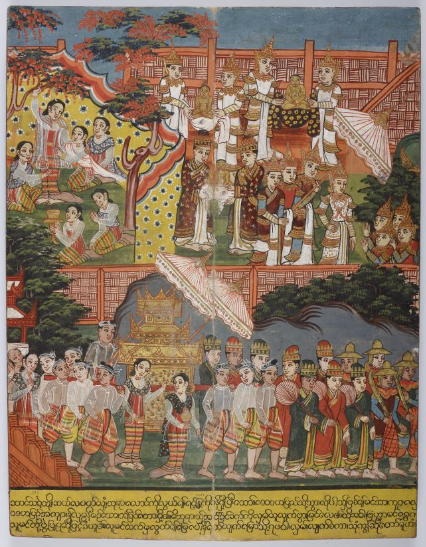1800s
Scenes from the Life of the Buddha
room Myanmar
These biographical scenes from the life of the Buddha are from various 19th-century Burmese manuscripts held in collections around the world. As well as telling the story of the Buddha’s life over two thousand years earlier, they reveal details of life in 19th-century Burma as the artists who have composed the scenes included elements their own surroundings with Burmese textiles, architecture, and cultural accessories.
The Birth of the Buddha: This rare mid-19th-century manuscript contains a scene showing the birth of Prince Siddharta, who would later become the Buddha. In the top left of the image, Queen Maha Maya has one hand on the branch of the Sal tree and the other on her sister as she gives birth. Top right, the court Brahmins perform the necessary rituals for the new-born prince.

Growing up, Before Becoming the Buddha: Another page of the same manuscript, held at the British Library, shows the young Prince Siddharta displaying his archery skills while his father, the king, participates in a ploughing ceremony. Prince Siddharta’s marriage to Princess Yasodhara is depicted in the golden-roofed pavillion. These scenes are from a parabeik (traditional Burmese books crafted from bark paper and folded horizontally) containing a total of 68 scenes and are available for viewing online at the British Library.

The Sleeping Orchestra: This parabeik scene depicts a critical moment in the life of Prince Siddharta – the moment his disillusionment with palace life makes him decide to forsake his life as a prince. It happened that he was listening to his personal orchestra playing and fell asleep. When he awoke, he saw that the orchestra had fallen asleep as well and were lying around in a slovenly manner. Notice the saung (Burmese harp) player who has fallen asleep on top of her harp. After this moment, Prince Siddharta bids farewell to his sleeping wife and child and leaves the palace. The manuscript can be viewed in its entirety via the British Library’s Digitised Manuscript Viewer.

The Buddha’s Eight Victories: On this parabeik page, the Buddha is taming the ogre, Ālavaka, who will later convert to Buddhism. Curiously, this parabeik is held in the vaults at Cotsen Children’s Library at Princeton University in the US and was digitized as part of a blog series called “Cotsen’s Covert Collections”, which documents the library’s rarer and more unusual holdings.

The Buddha gives a Sermon: This image shows the Buddha giving a sermon during Vassa (the three-month rainy season retreat observed by Buddhist monks and often referred to as Buddhist lent) while staying at Ghositārāma, a monastery in Kosambi built especially for his use. Notice the Burmese dress of his lay followers in this depiction. The full manuscript, available for online viewing at the British Library website, contains 25 scenes from the Buddha’s life including others scenes from Buddhist lent.

The First Kathina Ceremony: The end of Vassa is traditionally followed by Kathina, the robe offering ceremony in which lay people offer kathina, or cloth for monks' robes. This parabeik page depicts a scene from the life of the Buddha when he first granted his disciples permission to receive kathina robes and lay people from the city of Rajagaha brought them to the monastery. Here the Buddha is seated with offerings lined up in front of him and lay people waiting to offer more; the men with monks' robes and the women with baskets of fresh fruit. This is part of the Mālālaṅkāra vatthu manuscript painted in 1875 and available for viewing via the British Library’s Digitised Manuscript Viewer.

Explore more in Late Konbaung Myanmar and the English Wars (1824-1885AD)